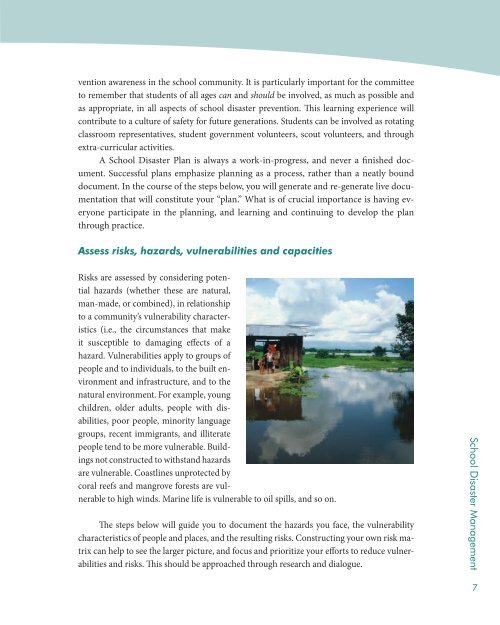Disaster and Emergency Preparedness: Guidance for ... - INEE Toolkit
Disaster and Emergency Preparedness: Guidance for ... - INEE Toolkit
Disaster and Emergency Preparedness: Guidance for ... - INEE Toolkit
You also want an ePaper? Increase the reach of your titles
YUMPU automatically turns print PDFs into web optimized ePapers that Google loves.
vention awareness in the school community. It is particularly important <strong>for</strong> the committeeto remember that students of all ages can <strong>and</strong> should be involved, as much as possible <strong>and</strong>as appropriate, in all aspects of school disaster prevention. This learning experience willcontribute to a culture of safety <strong>for</strong> future generations. Students can be involved as rotatingclassroom representatives, student government volunteers, scout volunteers, <strong>and</strong> throughextra-curricular activities.A School <strong>Disaster</strong> Plan is always a work-in-progress, <strong>and</strong> never a finished document.Successful plans emphasize planning as a process, rather than a neatly bounddocument. In the course of the steps below, you will generate <strong>and</strong> re-generate live documentationthat will constitute your “plan.” What is of crucial importance is having everyoneparticipate in the planning, <strong>and</strong> learning <strong>and</strong> continuing to develop the planthrough practice.Assess risks, hazards, vulnerabilities <strong>and</strong> capacitiesRisks are assessed by considering potentialhazards (whether these are natural,man-made, or combined), in relationshipto a community’s vulnerability characteristics(i.e., the circumstances that makeit susceptible to damaging effects of ahazard. Vulnerabilities apply to groups ofpeople <strong>and</strong> to individuals, to the built environment<strong>and</strong> infrastructure, <strong>and</strong> to thenatural environment. For example, youngchildren, older adults, people with disabilities,poor people, minority languagegroups, recent immigrants, <strong>and</strong> illiteratepeople tend to be more vulnerable. Buildingsnot constructed to withst<strong>and</strong> hazardsare vulnerable. Coastlines unprotected bycoral reefs <strong>and</strong> mangrove <strong>for</strong>ests are vulnerableto high winds. Marine life is vulnerable to oil spills, <strong>and</strong> so on.The steps below will guide you to document the hazards you face, the vulnerabilitycharacteristics of people <strong>and</strong> places, <strong>and</strong> the resulting risks. Constructing your own risk matrixcan help to see the larger picture, <strong>and</strong> focus <strong>and</strong> prioritize your ef<strong>for</strong>ts to reduce vulnerabilities<strong>and</strong> risks. This should be approached through research <strong>and</strong> dialogue.School <strong>Disaster</strong> Management7
















